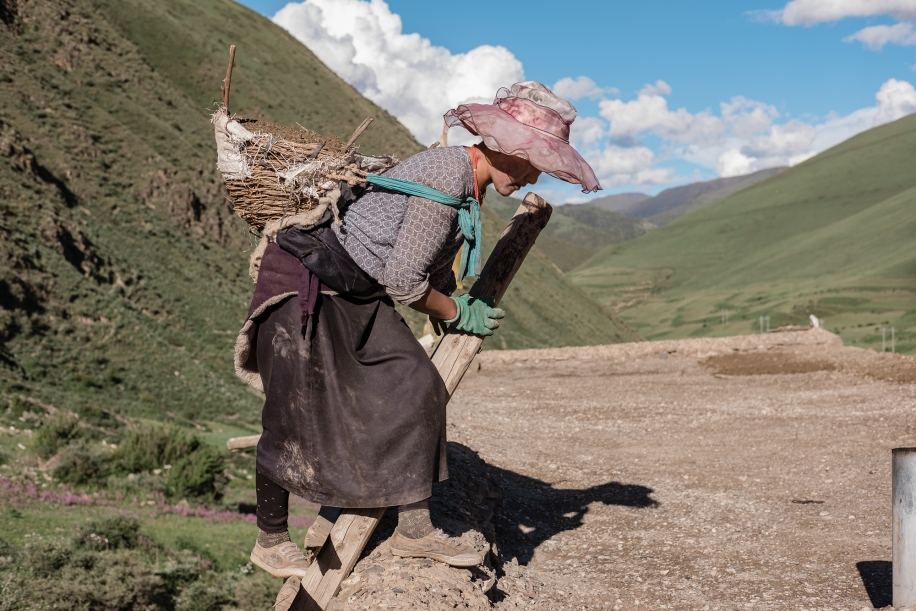

Jamyang Tsomo carries a handwoven basket filled with dirt up to the roof of her family’s home. After she has removed weeds and stones from the roof, she fills the dips and holes to prevent water leaks or collapse. Besides her mother, Jamyang Tsomo is the only woman in the household responsible for most of the domestic duties.
Jamyang Tsomo: The Daily Life of a Tibetan Woman
Eleanor Moseman | Garze Tibetan Autonomous Region, China
Photographer: Eleanor Moseman
Exhibit Title: Jamyang Tsomo: The Daily Life of a Tibetan Woman
Location: Garze Tibetan Autonomous Region, China
Jamyang Tsomo is a Tibetan woman living, with her family in a small community, in the remote mountains of Garze Autonomous Region. Now in her late 30s, unwed but with a three-year-old son, she is the primary caretaker of a household that also includes her elderly mother and three brothers that come and go. The presence and ability to contribute to the work depending on their migrant work, studies, or monastic obligations.
This project is an ongoing story of a woman that exemplifies dedication and bravery. Yet, it’s also about poverty and an alternate narrative to the common mythologized visions of Tibet. Jamyang Tsomo, like other Tibetans, lives in one of the most physically challenging environments and politically unstable region of the world. Like millions of others, she faces daily difficulties among work, life, family, culture, environment, and politics.
Eight years ago, while on a solo trek on the Tibetan Plateau, I came upon the village of Khana. I met two Tibetan women seated upon freshly tilled soil; the elder insisted I join her and her companion. After one cup of tea, hail and winds chased us into one of the women’s home. The storm passed yet we remained together through the evening; every morning I was told to stay one more day. I accepted her invite and during that week I met her daughter, Jamyang Tsomo; a quiet woman who labored in the shadows and who would eventually show her simple life was filled with hard work, poverty, and trauma.
After an emotional goodbye, and with no means of remaining in contact, I returned in 2016. I was immediately welcomed back. Jamyang Tsomo and I grew close; relying on funny noises and gestures to express ourselves through the complicated language barrier. Since 2016, I’ve made numerous visits to document traditional Tibetan life in this remote and overlooked part of the country and to tell the story of Jamyang Tsomo: a woman born into poverty and who has matured into a vision of a modern-day warrior.
Jamyang Tsomo is in her mid-30’s, unwed, and until recently, childless, and the caretaker of a household that includes her mother and three brothers. It’s rare for women to remain unmarried past their early twenties. Her mother says it’s because “she doesn’t look good.” And her culture treats her like an adolescent because she has not had children. Despite these constant criticisms and adversities, Jamyang Tsomo confronts every day with humor and strength.
On a typical summer day, Jamyang Tsomo wakes before sunrise to milk the yaks and finally closes her eyes after midnight. Her hours are filled with menial household chores such as laundry, dishes, and sending livestock to roam. Life on the Tibetan Plateau may appear static and routine, yet there are significant differences as the climate changes throughout the year.
Late spring is the beginning of the season of nomadic life. Jamyang Tsomo will take yaks and horses high into the mountains and live at a camp for months at a time. The little valley nestled among the peaks is home to tents with dozens of women and the area comes alive with smells of campfires and milk. Work and life are labor-intensive and after the yaks are milked and sent to graze, the women spend the remaining hours of light on their hands and knees harvesting Tibetan fungus caterpillars: the mummified moth larvae that has been taken over by a fungus thrives at the high altitudes of the Himalayas. The dried worm is eventually sold as a valuable Chinese medicine.
Summer is the season to harvest barley; a staple of the Tibetan diet. The grain is finely milled and then prepared in a small bowl with tea and butter to create a staple food called “tsampa.” During the 2017 barley harvest Jamyang Tsomo fell off the back of a tractor and suffered a severe injury that removed enough skin to expose her skull. Without a hospital nearby, she had to travel two days by car to the city of Chengdu for three emergency skin grafts on her forehead. Besides her pain and distress at the time, she also couldn’t communicate with the Han doctor who spoke in Mandarin. And her illiteracy prevented her from writing her name; other Tibetan patients and visitors helped her communicate. Chinese hospitals can pose problems for ethnic minorities such as Tibetans. In some instances, patients use another person’s government ID or bribe hospital staff for treatment. In addition to her limited access to healthcare and the benefits of a social welfare system, Jamyang Tsomo was never offered an education.
I was in the Tibetan region, with attempts to arrive at Jamyang Tsomo’s house in January 2020. Covid was spreading rapidly from the Eastern region of China. After canceled flights, continual police interrogations, and hotels denying my stay, I was forced out and returned to the United States. Jamyang Tsomo’s infant was four months old, and we all had been anxiously awaiting my return. There are plans to return later this year, and the latest would be 2024, while I look forward to sharing Jamyang Tsomo’s story with the world. She represents bravery, resilience, womanhood, and the difficult life many Tibetans face.
In the coming years I will continue to document the lives, struggles and tribulations of Jamyang Tsomo, while creating a visual archive of the Tibetan people and culture.
Eleanor Moseman
www.eleanormoseman.com
eleanor.moseman@gmail.com
1.937.829.5103
Make Comment/View Comments